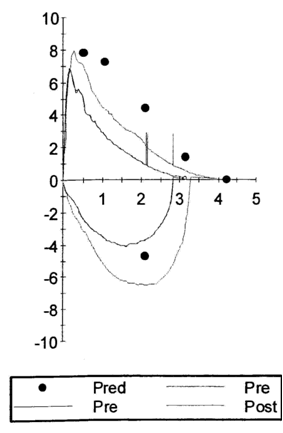
Pulmonary Function Testing
Case 3 Answer
A 60 year-old man presents to his primary care provider with complaints of increasing dyspnea on exertion. He has a 40 pack-year history of smoking and is retired following a career as a building contractor.
His pulmonary function testing is as follows:
| Pre-Bronchodilator (BD) | Post- BD | ||||
|---|---|---|---|---|---|
| Test | Actual | Predicted | % Predicted | Actual | % Change |
| FVC (L) | 1.89 | 4.58 | 41 | 3.69 | 96 |
| FEV1 (L) | 0.89 | 3.60 | 25 | 1.89 | 112 |
| FEV1/FVC (%) | 47 | 79 | |||
| RV (L) | 5.72 | 2.31 | 248 | ||
| TLC (L) | 7.51 | 6.41 | 117 | ||
| RV/TLC (%) | 76 | 37 | |||
| DLCO* corr | 20.73 | 33.43 | 62 | ||
| *DLCO is measured in ml/min/mmHg | |||||
| Check abbreviations>> | |||||
His flow volume loops is as follows:

Case 3 Interpretation
This patient has markedly abnormal spirometry. The FVC is only 41% predicted while the FEV1 is only 25% predicted, well below the lower limit of normal of 80% predicted. In addition, the FEV1/FVC ratio is markedly reduced. The combination of the low FEV1, FVC and reduced FEV1/FVC ratio is consistent with a diagnosis of airflow obstruction. With an FEV1 of 25% predicted, this would be classified as “severe” airflow obstruction.
The patient also meets criteria for reversible airflow obstruction as both the FEV1 and FVC improve by over 200 ml and 12% following administration of a bronchodilator.
In addition to these abnormalities on spirometry, the patient has a markedly elevated residual volume (RV), a finding that is indicative of air-trapping. The total lung capacity (TLC) is somewhat elevated at 117% predicted but it is still shy of the 120% predicted level used to define hyperinflation.
UW School of Medicine : School of Medicine Mission
Copyright and Disclaimer : Credits and Acknowledgements